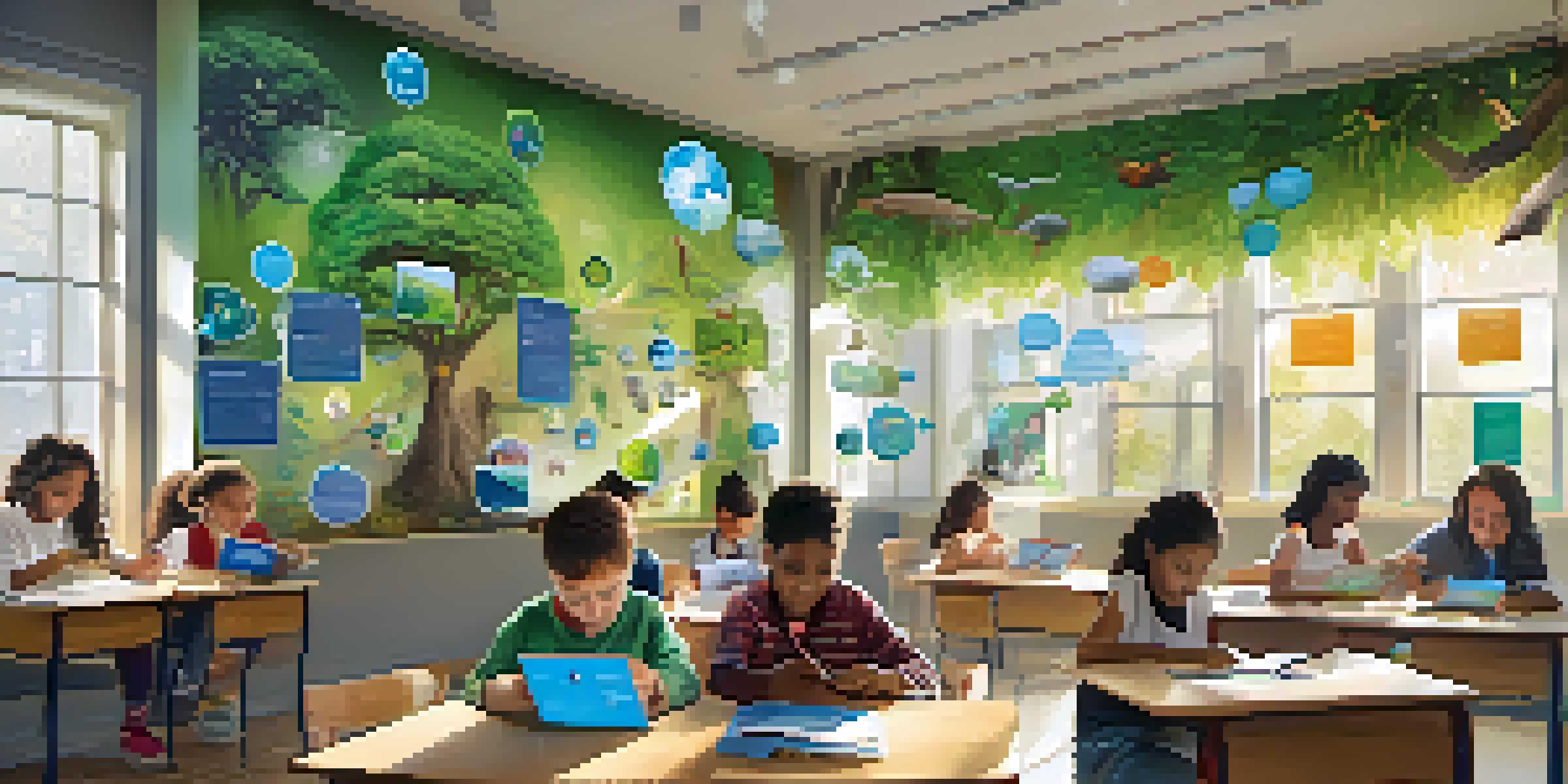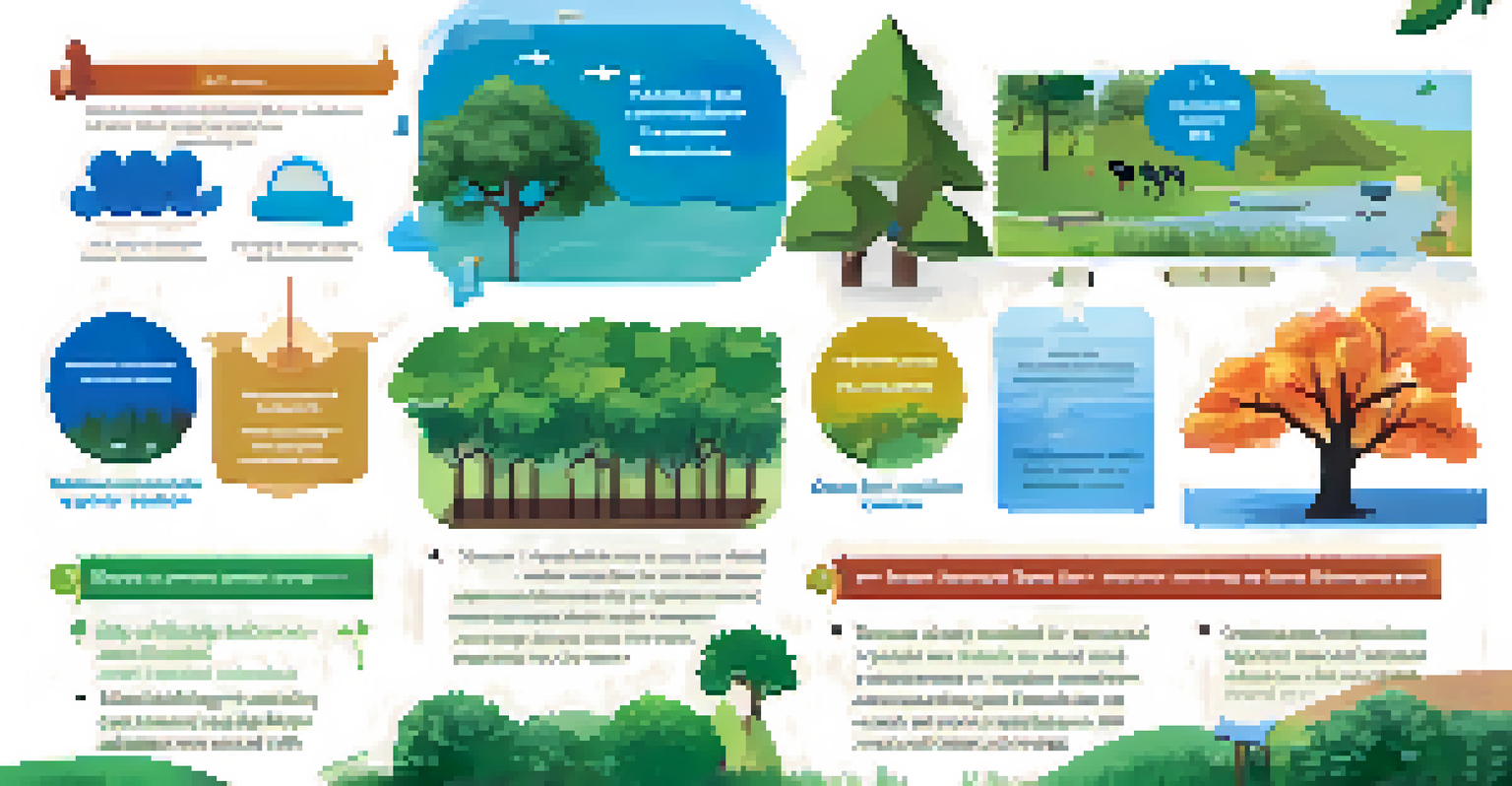Exploring the Role of OER in Environmental Education

Understanding Open Educational Resources (OER)
Open Educational Resources (OER) refer to freely accessible teaching materials, which can be used for various educational purposes. They range from textbooks and lecture notes to videos and interactive activities, all designed to enhance learning without the financial burden. The beauty of OER lies in their adaptability; educators can modify and share these resources to fit their specific teaching needs and local contexts.
Education is the most powerful weapon which you can use to change the world.
In the realm of environmental education, OER play a pivotal role by providing educators and students with up-to-date, relevant content that reflects current environmental issues. For instance, a teacher might use an OER module on climate change, which includes case studies, interactive simulations, and assessment tools. This flexibility not only enriches the learning experience but also promotes active engagement with the material.
Moreover, OER can bridge gaps in educational resources, particularly in underfunded areas. By offering high-quality materials at no cost, OER empower educators in diverse settings to provide their students with a comprehensive understanding of environmental issues, fostering a generation of informed and responsible citizens.
The Benefits of OER in Environmental Education
One of the most significant benefits of OER in environmental education is accessibility. Unlike traditional textbooks that can be expensive, OER are available to anyone with an internet connection, ensuring that students from all socio-economic backgrounds have equal opportunities to learn. This democratization of knowledge is crucial for fostering a more inclusive learning environment.

Additionally, OER facilitate collaboration among educators. Teachers can share their customized resources with colleagues, allowing for the exchange of ideas and best practices. For example, a science teacher might collaborate with a local environmental organization to create a comprehensive OER that addresses local ecological issues, enhancing the relevance of the content for their students.
OER Enhances Accessibility in Education
Open Educational Resources provide free access to high-quality teaching materials, ensuring that students from all backgrounds can learn about important environmental issues.
Lastly, OER support lifelong learning by encouraging continuous exploration of environmental topics. As new challenges arise, such as biodiversity loss or renewable energy developments, OER can be quickly updated to reflect these changes. This adaptability ensures that both educators and learners are always equipped with the most current information, promoting ongoing engagement with environmental education.
Examples of OER in Environmental Education
Many organizations and institutions have created OER specifically tailored for environmental education. For instance, the Environmental Protection Agency (EPA) offers a variety of resources that include lesson plans, videos, and interactive quizzes focused on environmental science. These materials can be easily integrated into classroom activities, making learning about the environment engaging and fun.
The only way to make sense out of change is to plunge into it, move with it, and join the dance.
Another excellent example is the OpenCourseWare initiative from universities, which provides free access to a range of courses related to environmental studies. Students can explore topics such as sustainable development, ecology, and environmental policy at their own pace, using high-quality materials developed by expert educators. This self-directed approach empowers learners to take charge of their education.
Moreover, platforms like OER Commons host a wealth of user-generated content that focuses on environmental topics. Educators can search for resources by grade level, subject matter, or even specific environmental issues, ensuring they find relevant materials that meet their instructional goals. This vast repository encourages creativity and innovation in teaching.
Challenges in Implementing OER in Environmental Education
Despite the many advantages of OER, several challenges can hinder their implementation in environmental education. One major obstacle is the digital divide; not all students have reliable internet access or the necessary technology to utilize OER fully. This disparity can create inequalities in learning opportunities, especially in rural or underserved areas.
Another challenge is the perception of quality. Some educators may be skeptical about the reliability of OER compared to traditional resources. It’s crucial to establish clear standards for OER and promote peer-reviewed materials to build trust and confidence among educators. Collaborative efforts among institutions can help to curate high-quality resources that meet these standards.
Collaboration Boosts OER Utilization
OER fosters collaboration among educators, allowing them to share tailored resources and best practices, which enhances the relevance and effectiveness of environmental education.
Lastly, there is often a lack of training for educators on how to effectively integrate OER into their teaching. Professional development opportunities that focus on OER usage can help teachers feel more comfortable and capable of incorporating these resources into their lessons. By investing in training, we can ensure that OER are utilized to their full potential in the classroom.
OER and Student Engagement in Environmental Topics
OER are not just about providing information; they also play a crucial role in enhancing student engagement with environmental topics. Interactive resources, such as simulations and gamified learning experiences, can make complex environmental concepts more accessible and enjoyable. For example, a game that simulates the effects of pollution on ecosystems can captivate students and encourage them to think critically about their role in environmental stewardship.
Moreover, students often feel more connected to their learning when they can explore real-world issues through OER. By using case studies and local environmental challenges, educators can create a curriculum that resonates with students’ lives. This relevancy fosters a sense of ownership and responsibility, motivating them to take action in their communities.
Additionally, the collaborative nature of OER allows students to contribute their own findings and projects, further increasing engagement. For instance, students might create a multimedia presentation on a local environmental issue and share it as an OER for others to use. This not only reinforces their learning but also promotes a culture of sharing and collective problem-solving.
The Future of OER in Environmental Education
As technology continues to evolve, so too will the landscape of OER in environmental education. Innovations such as virtual reality and augmented reality have the potential to transform how students interact with environmental concepts. Imagine students exploring a coral reef ecosystem through a VR headset, gaining a visceral understanding of its fragility and beauty.
Furthermore, the open nature of OER encourages global collaboration among educators and institutions. By sharing resources across borders, we can foster a more comprehensive understanding of environmental challenges that transcend national boundaries, such as climate change and pollution. This collaborative approach can lead to shared solutions and a more unified response to urgent global issues.
OER Adaptable for Lifelong Learning
The flexibility of OER supports ongoing learning and engagement by allowing materials to be updated quickly in response to new environmental challenges.
Ultimately, the future of OER in environmental education looks promising. As we continue to embrace open access and innovative teaching methods, we can inspire a new generation of learners who are equipped to tackle the pressing environmental challenges of our time. Together, we can create a more sustainable future for all.
Conclusion: Embracing OER for Environmental Education
In conclusion, Open Educational Resources hold immense potential for transforming environmental education. By making high-quality, accessible resources available to educators and learners, OER can enhance understanding and engagement with critical environmental issues. The flexibility and adaptability of OER empower educators to tailor their teaching to meet the needs of their students and local contexts.
While challenges exist in the implementation of OER, addressing these obstacles through collaboration and training can pave the way for a more equitable educational landscape. By embracing OER, we can ensure that all students, regardless of their background, have the opportunity to learn about and engage with the environment.

As we look to the future, it's essential to continue advocating for the use of OER in environmental education. With a collective effort, we can foster a generation of environmentally-conscious individuals who are not only aware of the challenges but also motivated to create positive change in their communities and beyond.